Look and Listen for a Common Yellowthroat
Updated: May 13, 2024
Learn what a common yellowthroat looks like and sounds like, what the bird eats, and the range and habitat where you can spot one.
On This Page
Common Yellowthroat Song
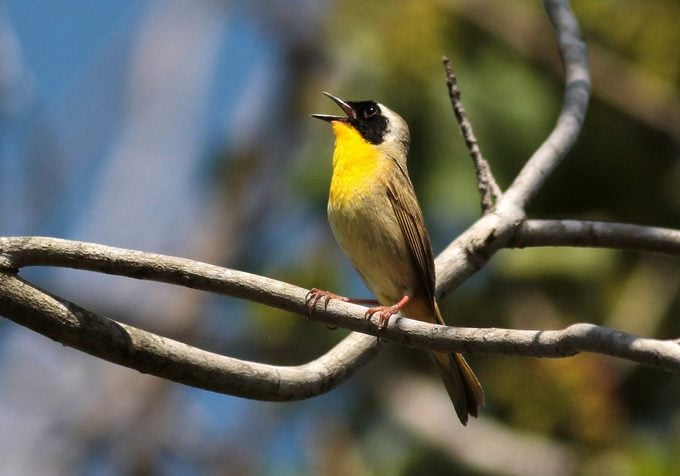
Step into your backyard on a summer morning, and you’re likely to be greeted by a chorus of chirps and trills. Robins are carol cheerily cheer-up, and chickadees scold chickadee-dee-dee-dee. Suddenly, a different tune stands out, a snappy wichity-wichity-wichity. A search toward the sound along an unruly hedge reveals a common yellowthroat.
Often, it’s the sound of this colorful warbler rather than its bold black and yellow plumage that you first notice. Common yellowthroats are not rare but they are elusive, mostly staying within the protective cover of shrubs. What a treat to hear and see one!
The song is also sometimes described as which-is-it, which-is-it, which-is-it. Also listen for a throaty, almost guttural call, best described as a low tchuck, when the bird is hidden in a brambly bush or tangle of low shrubs and grass.
Bird sounds courtesy of The Cornell Lab of Ornithology
What Does a Common Yellowthroat Look Like?
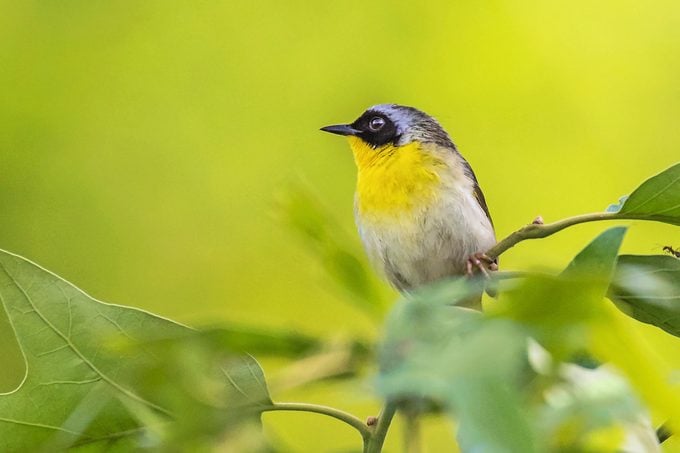
As their name suggests, a mature male common yellowthroat has a distinctive bright yellow throat. Sometimes nicknamed “yellow bandit” due to its prominent black mask, it’s similar in size to a sparrow, about five inches long with a medium-long tail, olive back, and sharp beak. Females also have a yellow throat, though paler, with a brownish head and back and no mask.
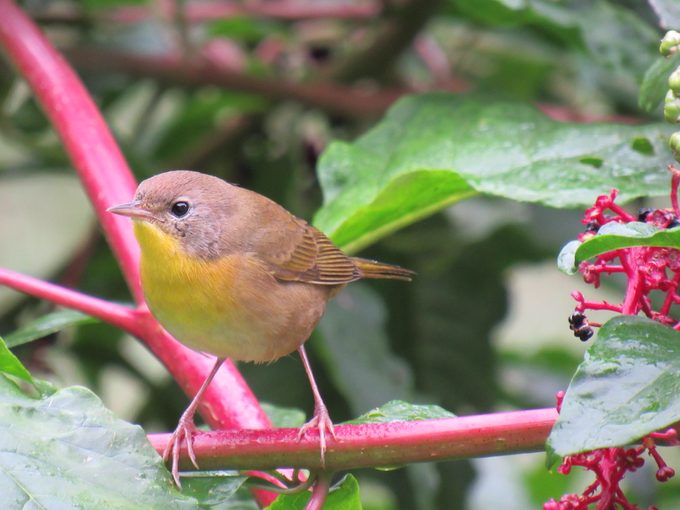
“The first time I saw photo of a male common yellowthroat, I knew that this was a bird I could identify without having to figure out whether it has an eye ring or faint wing bars, or some other minute detail,” says Pam Otto, a naturalist with the St. Charles, Illinois Park District who teaches birding classes and leads birding walks.
“His black mask and yellow throat are so bold and unique that the species is unmistakable. That is, if you can see him. The other thing I love about these birds is their elusiveness. They’re often heard, but seeing them is another matter entirely. I always feel lucky if I’m able to spot a common yellowthroat singing,” she says.
Range and Habitat
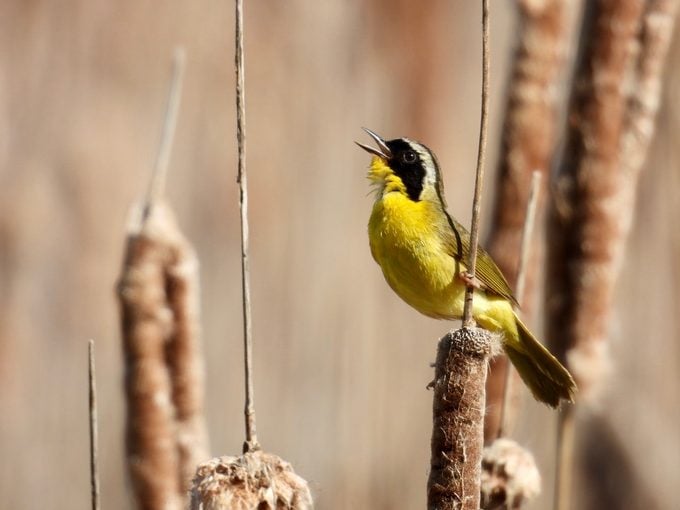
Common yellowthroats breed in the low, dense, tangled vegetation around wetlands and riparian areas across North America, though you can sometimes spot them along the edges of drier upland forests and hedgerows. Although they try to remain out of sight, you might see one flit out of the reeds to snatch a bug, perch atop a cattail to call out its territory, or simply because its curious about an unfamiliar sound.
As summer wanes, yellowthroats migrate, traveling at night, to similar marshy habitats in the southern United States and as far south as Central America.
Common Yellowthroat Nesting Habits
“Common yellowthroats are the only warblers in the United States that actually nest in marshes,” says Pam. “Prothonotary warblers can be found in tree cavities in swamps, but marshes typically are treeless. Yellowthroats usually nest in low vegetation or on the ground, so a lack of trees is not an issue for them.”
The males arrive first in the spring, loudly proclaiming their spot and to attract a mate, though the females are often unfaithful after courtship. After mating, a female weaves a well-hidden, cup-shaped nest out of grasses, leaves and sedges, sometimes with a roof. She then lays one to six white, speckled eggs. The chicks hatch in just 12 days.
Both the male and the female feed the chicks, which fledge in eight to 12 days.
What Do Common Yellowthroats Eat?
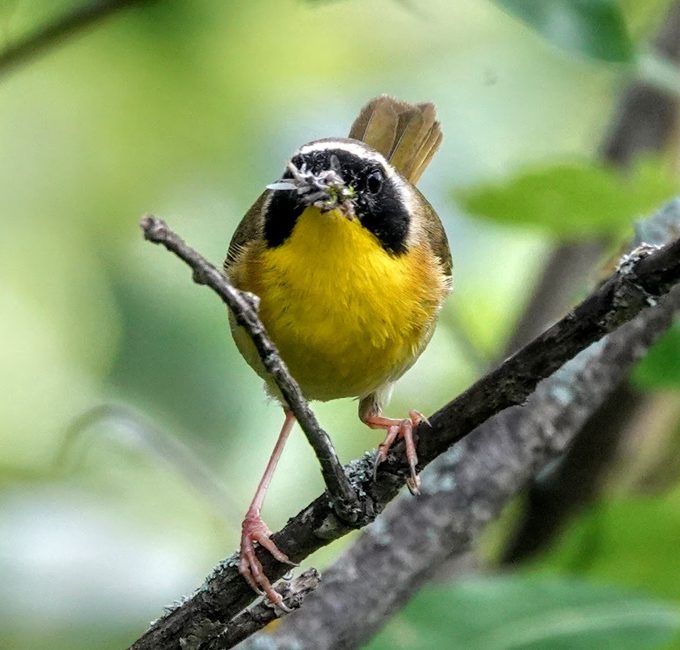
Like other warblers, the common yellowthroat primarily eats insects, spiders and insect larvae. They pluck bugs off low vegetation and sometimes from the air, but they’ll also they’ll also snack occasionally on flower nectar or small fruits.
While not typically attracted to a feeder, they might pass through your backyard while migrating if the yard is big enough (at least a half-acre) and not immaculately manicured.
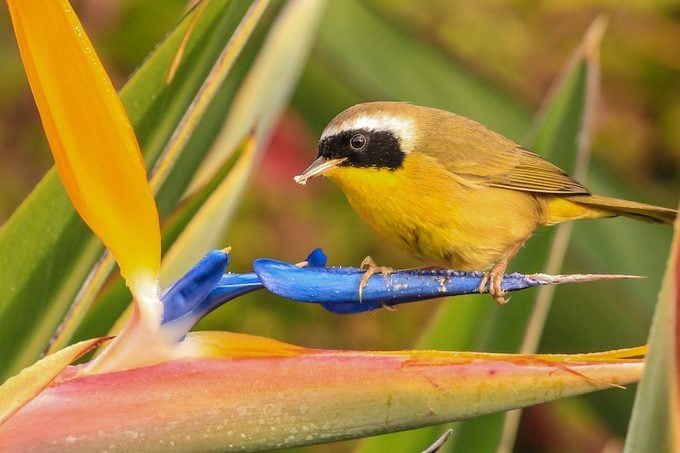
“Most yards are too neat or too small to be of interest to common yellowthroats, but if someone has a large piece of property, ideally near a wetland, and they have lots of sedges, grasses and other plants that have dense, tangled growth habits, the common yellowthroats will find them,” says Pam.
About the Expert
Pam Otto is an outreach ambassador and naturalist with the St. Charles Park District in St. Charles, Illinois. She has taught birding classes and led birding walks for 25 years.
Sources
- All About Birds – common yellowthroat
- National Audubon Society – common yellowthroat
- Smithsonian’s National Zoo – common yellowthroat
- Interview with Pam Otto
Why Trust Us
For nearly 30 years, Birds & Blooms, a Trusted Media Brand, has been inspiring readers to have a lifelong love of birding, gardening and nature. We are the #1 bird and garden magazine in North America and a trusted online resource for over 15 million outdoor enthusiasts annually. Our library of thousands of informative articles and how-tos has been written by trusted journalists and fact-checked by bird and garden experts for accuracy. In addition to our staff of experienced gardeners and bird-watchers, we hire individuals who have years of education and hands-on experience with birding, bird feeding, gardening, butterflies, bugs and more. Learn more about Birds & Blooms, our field editor program, and our submission guidelines.





















